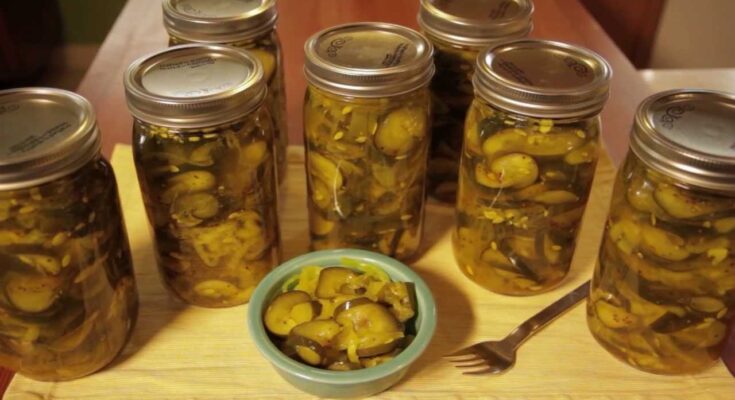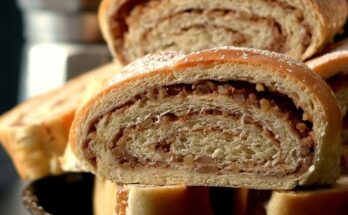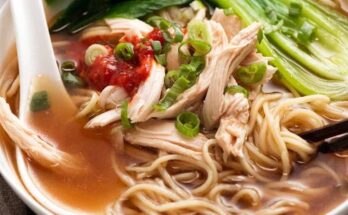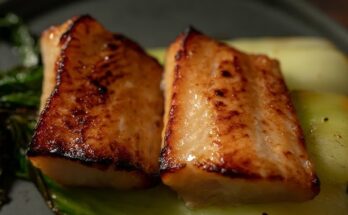Bread and Butter Pickles Recipe: Bread and butter pickles are a staple in many kitchens for a reason. These sweet, tangy, and slightly zesty slices of cucumber are more than just a sidekick to your sandwich—they’re a nostalgic bite of homemade goodness. Unlike sour dill pickles, bread and butter pickles bring a sweet-savory punch that complements everything from grilled cheese to fried chicken. They’re often thinly sliced, making them ideal for stacking, snacking, and stirring into salads or relishes.
Their unique flavor comes from a balance of vinegar, sugar, and a blend of spices that include mustard seeds, turmeric, and celery seeds. The magic lies in this harmony of ingredients—no one flavor outshines the other, yet together, they create something unforgettable.
So, why are they called “bread and butter” pickles? That’s not because they contain bread or butter. Instead, it’s believed they were so named during the Great Depression when these pickles served as a simple, affordable meal when paired with slices of buttered bread. Essentially, they were the everyday man’s sandwich filling—hearty, flavorful, and comforting.
A Brief History and Origin
The story of bread and butter pickles dates back to the 1920s, thanks to Omar and Cora Fanning, a farming couple in Illinois. The Fannings trademarked the name “Fanning’s Bread and Butter Pickles,” and started selling their homemade pickle recipe during the Great Depression. As cucumbers were plentiful and cheap, pickling them was an excellent way to preserve excess produce and make ends meet.
These pickles gained popularity for their incredible flavor and shelf stability. Generations later, the recipe has evolved slightly with regional tweaks and flavor enhancements, but the essence remains the same: a sweet and tangy pickle with a slight crunch that brightens up any dish.
Ingredients Needed
Core Ingredients
To make authentic, mouth-watering bread and butter pickles, you’ll need some key ingredients. Here’s your basic grocery list to get started:
- Fresh cucumbers (pickling cucumbers preferred) – 6 cups, thinly sliced
- Onions – 2 medium, thinly sliced (yellow or white work best)
- Kosher salt – 1/4 cup (for soaking)
- Apple cider vinegar – 2 cups
- White sugar – 1 1/2 cups
- Brown sugar – 1/2 cup (optional for a richer sweetness)
- Mustard seeds – 1 tablespoon
- Celery seeds – 1/2 tablespoon
- Ground turmeric – 1/2 teaspoon
- Crushed red pepper flakes – 1/4 teaspoon (optional for heat)
These ingredients give the pickles their signature sweet-tart taste and vibrant yellow color. Apple cider vinegar is particularly essential for that mellow acidity that pairs so well with the sugar.
Optional Add-ons for Flavor Variations
Want to make your pickles stand out? You can customize your recipe with a few optional ingredients:
- Garlic cloves – Add 2-3 crushed cloves for a garlicky twist.
- Fresh dill sprigs – For a hint of herbal freshness.
- Allspice or clove – Add a pinch for a spicier aroma.
- Bay leaf – Gives an earthy note that adds depth to the brine.
These additions allow you to tweak the flavor to your liking. Experimentation is part of the fun, so don’t hesitate to try new combinations once you’ve nailed the basic recipe.
Tools and Equipment Required
Before diving into pickling, make sure you’ve got the right tools on hand. Having everything ready makes the process smoother and safer—especially when dealing with boiling liquids and glass jars.
Here’s what you’ll need:
- Cutting board and sharp knife or a mandoline slicer
- Large bowl (for salting and soaking cucumbers)
- Colander (to drain salted cucumbers)
- Large non-reactive pot (for boiling the brine)
- Canning jars with lids and bands (preferably pint-sized or half-pint)
- Jar lifter or tongs
- Funnel (for pouring hot liquid into jars)
- Canning rack or a thick towel for water bath canning
- Stockpot or canner (for the boiling water bath)
Using the right tools ensures that your pickles are safely processed and can be stored for months without spoilage. It’s also about making the process efficient and enjoyable—no one likes spilling hot brine or struggling with sealing jars.
Preparing the Cucumbers
Slicing Techniques
Properly slicing your cucumbers is the first step toward a successful batch of pickles. Consistency is key here. You want thin, even slices—about 1/8 to 1/4 inch thick. This allows the brine to penetrate quickly and evenly, ensuring every slice is packed with flavor.
A sharp chef’s knife works just fine, but a mandoline slicer can speed things up and ensure uniform slices. Be careful with your fingers if you use one—safety first! If you prefer a crunchier pickle, you can slice them a little thicker. Thin slices, on the other hand, absorb flavor faster and have a softer texture.
Also, don’t forget to wash and trim the ends of your cucumbers. Removing the blossom end is essential because it contains enzymes that can soften the pickles during storage.
Salting and Soaking
Salting is a crucial step in creating that crave-worthy pickle crunch. Once your cucumbers (and onions, if using) are sliced, toss them with kosher salt in a large bowl. Layer them generously, then cover the mixture with ice cubes and let it sit for 1.5 to 2 hours.
This process draws out excess moisture from the cucumbers, helping them stay crisp once they’re soaked in the brine. After soaking, rinse the cucumbers and onions thoroughly under cold water to remove the excess salt. Drain well in a colander and pat them dry using a clean towel or paper towels.
Skipping this step could leave your pickles soggy, so don’t rush it. Good things—especially pickles—take time.
Making the Brine
Sweet and Tangy Brine Mix
The heart and soul of any bread and butter pickle recipe is the brine. This is where all the flavor comes from. It’s a perfectly balanced mix of sweet, tangy, and slightly spicy, depending on how adventurous you want to get. Here’s how to build the perfect brine base.
In a large non-reactive saucepan (like stainless steel or enameled cast iron), combine:
- 2 cups of apple cider vinegar
- 1½ cups of white sugar
- ½ cup of brown sugar (optional but adds depth)
- 1 tablespoon of mustard seeds
- ½ tablespoon of celery seeds
- ½ teaspoon of ground turmeric
- ¼ teaspoon of crushed red pepper flakes (optional for heat)
Gently stir the mixture and bring it to a slow boil over medium heat. Once the sugar is fully dissolved, you’re good to go.
Turmeric is what gives bread and butter pickles their signature yellow hue, while mustard seeds and celery seeds offer a subtle but irresistible complexity. Red pepper flakes bring a whisper of heat that lingers just enough without overwhelming.
If you’re looking for a brine that leans more tart than sweet, reduce the sugar slightly and increase the vinegar. But for that classic bread and butter flavor, keep the proportions close to this standard.
Heating the Brine Properly
It’s important not to skip or rush the boiling stage. Bringing the brine to a boil ensures the sugar dissolves and the flavors meld beautifully. This also helps with preservation, killing any lingering bacteria before it hits your jars.
As soon as your brine reaches a nice rolling boil, lower the heat and let it simmer for a couple more minutes to deepen the flavor. At this stage, your kitchen should smell amazing—sweet, tangy, and full of spice. It’s a sensory preview of what’s to come!
Combining Cucumbers with Brine
Simmering for Flavor Infusion
Now that your brine is ready and your cucumbers are sliced, salted, rinsed, and dried, it’s time to marry them together. Carefully add the cucumber and onion mixture to the hot brine.
Keep the heat on low to medium and let the whole mixture simmer gently for about 5 to 7 minutes. Don’t overcook them—you want the cucumbers to stay crisp and not turn mushy. The goal is to let the cucumbers absorb the flavors while still holding their texture.
Stir occasionally with a wooden spoon or silicone spatula, gently pushing the cucumbers down to make sure they’re submerged and getting evenly coated with the brine. As they soak and simmer, you’ll notice the cucumbers starting to soften slightly and turn a lovely yellow from the turmeric.
Once they’re infused and slightly translucent, you’re ready to move on to the canning stage. This part is all about patience and timing. A rushed soak means bland pickles; an overcooked batch loses that signature crunch.
Sterilizing the Jars
Why Sterilization is Essential
Sterilizing jars isn’t just a formality—it’s a crucial step to ensure your pickles stay safe to eat for months (or even years) without refrigeration. Harmful bacteria like botulism can develop if the canning process isn’t done properly, and sterilizing is your first defense.
Whether you’re planning to store your pickles in the pantry or give them as gifts, sterile jars are a must. Besides, you’ve put all this love into your pickles—why risk it?
Step-by-Step Jar Sterilization
Here’s a foolproof way to sterilize your jars:
- Wash the jars and lids in hot soapy water. Rinse them thoroughly.
- Boil the jars in a large pot of water for at least 10 minutes. Make sure they’re fully submerged.
- Remove with tongs and place them upside down on a clean towel or drying rack. Let them air dry completely.
- Keep the jars hot until ready to use—this prevents them from cracking when you pour in the hot brine. You can leave them in the warm water or keep them in a 200°F oven.
It’s just a few extra minutes, but it makes all the difference. Never skip the sterilization process if you’re planning long-term storage.
Canning the Pickles
Hot Water Bath Method
Once your jars are sterilized and your pickles are hot and ready, it’s time to can them! The hot water bath method is ideal for acidic recipes like pickles, and it’s beginner-friendly.
- Fill your jars with the pickles and onions using a ladle or slotted spoon. Don’t pack them too tight—leave room for the brine.
- Add the hot brine to the jars, covering the cucumbers completely. Leave about ½ inch of headspace at the top.
- Wipe the rims of the jars clean with a damp cloth.
- Place the lids on and screw the bands until they’re fingertip-tight.
Next, lower the jars into a boiling water bath using a jar lifter. Make sure the jars are covered by at least an inch of water. Boil for 10 minutes (adjust for altitude if necessary).
Once done, carefully remove the jars and let them cool on a towel-lined counter. You’ll hear that satisfying “pop” as the lids seal—music to a pickler’s ears!
Sealing the Jars for Long-Term Storage
As the jars cool, check the seals by pressing the center of each lid. If it doesn’t flex up and down, you’re sealed. Any jar that didn’t seal properly should be refrigerated and used first.
Let the jars sit undisturbed for 12 to 24 hours. Label each one with the date and store them in a cool, dark place. Your bread and butter pickles will be at their flavorful best after about two weeks, but they’ll keep for up to a year if stored properly.
Storing Your Pickles
Proper storage is key to preserving the vibrant taste and crisp texture of your homemade bread and butter pickles. Once your jars are sealed and cooled, you have two main options: pantry storage or refrigerator pickles.
For pantry storage, make sure your jars have sealed properly (no lid flex) and place them in a cool, dark space like a cupboard or basement. Here, they can last up to a year without spoiling. Avoid exposing the jars to direct sunlight or extreme temperature fluctuations, as that can cause discoloration and degrade the flavor.
If you didn’t go through the canning process and simply poured the hot brine over the cucumbers and stored them in the fridge, that’s okay too. These are called refrigerator pickles and will still taste amazing—but they’ll only last about 2 to 3 months. Always use clean utensils when handling the pickles to avoid introducing bacteria that could shorten their shelf life.
Label each jar with the date of preparation. For best flavor, let your pickles sit for at least 2 weeks before opening. This aging period allows the flavors to meld and mature. Once opened, keep them refrigerated and enjoy within 4 to 6 weeks for optimal crunch and taste.
Serving Suggestions
Classic Sandwich Add-on
Bread and butter pickles shine brightest in the simplest places—like stacked high on a sandwich. Their sweet and tangy flavor cuts through rich, fatty meats like roast beef, pastrami, or turkey. They also complement grilled cheese sandwiches beautifully, offering a pop of flavor that balances the creamy, melted cheese.
Try layering them inside a classic burger for an added zing. Or slice them finely and toss them into a chicken salad or tuna salad for a burst of sweet acidity. If you’re a fan of Southern food, you already know that no fried chicken plate is complete without a side of bread and butter pickles.
Their thin, uniform slices are perfect for layering, and their balanced flavor doesn’t overpower—making them one of the most versatile condiments in your fridge.
Creative Uses in Recipes
Bread and butter pickles aren’t just a side dish—they can be the star of the show. Here are some clever ways to use them:
- Pickle Slaw: Mix chopped pickles with shredded cabbage, mayo, and a bit of pickle juice for a tangy twist on coleslaw.
- Pickle Relish: Blend or finely dice pickles to make a sweet relish for hot dogs and bratwurst.
- Deviled Eggs: Add finely chopped pickles to your yolk filling for a surprising sweet crunch.
- Potato Salad: Ditch the vinegar or mustard and add diced pickles to potato salad for flavor without the bite.
- Pickle-Brined Chicken: Use leftover pickle brine to marinate chicken for ultra-juicy meat with a sweet-savory edge.
Get creative! These pickles are way more than a garnish—they’re a game-changer in all kinds of recipes.
Common Mistakes to Avoid
Even the simplest recipes can go sideways without a little know-how. Here are some common missteps to avoid when making bread and butter pickles:
- Skipping the salting step: This is essential for a crunchy texture. Don’t skip it or rush it.
- Using the wrong vinegar: Apple cider vinegar gives the best balance of sweet and tangy. White vinegar is too sharp and flat in flavor.
- Overcooking the cucumbers: Simmering too long turns them mushy. Keep it under 10 minutes.
- Not sterilizing jars properly: This can cause spoilage and health risks.
- Overfilling the jars: Always leave about ½ inch of headspace to ensure a proper seal.
- Ignoring spice balance: Don’t go heavy-handed on turmeric or mustard seeds—they’re powerful.
- Not letting the pickles rest: They need time to absorb all the brine and develop flavor. Opening them too soon will leave you disappointed.
Avoid these pitfalls and your pickles will turn out perfect every time!
Tips for Perfect Bread and Butter Pickles Every Time
Want to master the art of pickle-making? These tips will help you step up your game:
- Use pickling cucumbers. These are smaller and crunchier than regular cukes, making them ideal for pickling.
- Slice consistently. A mandoline slicer gives even slices that pickle uniformly.
- Use kosher or pickling salt. Table salt often contains additives that can cloud your brine or affect flavor.
- Chill your cucumbers before slicing. This helps preserve their crunch during the pickling process.
- Adjust sweetness to taste. Like your pickles less sweet? Cut back the sugar a little. Like a richer profile? Add a bit of brown sugar or honey.
- Experiment with spices. Add whole cloves, bay leaves, or even a cinnamon stick for unique twists.
These small tweaks can elevate your pickles from good to unforgettable.
FAQs about Bread and Butter Pickles Recipe
1. What are bread and butter pickles?
Bread and butter pickles are a sweet and tangy type of pickled cucumber made with vinegar, sugar, and spices. They’re known for their crunchy texture and signature flavor, perfect for sandwiches, burgers, or snacking.
2. Why are they called bread and butter pickles?
The name likely comes from the Great Depression era when people would eat these pickles with slices of bread and butter as a simple, affordable meal.
3. How long do bread and butter pickles last?
When stored in a sealed jar in the refrigerator, homemade bread and butter pickles can last up to 2–3 months. If canned properly, they can last up to a year in a cool, dark place.
4. Can I use apple cider vinegar instead of white vinegar?
Yes! Apple cider vinegar adds a slightly different, more robust flavor. Just make sure it has at least 5% acidity for safe pickling.
5. Are bread and butter pickles gluten-free?
Most recipes are naturally gluten-free, but always check the ingredients, especially the vinegar and spices, to ensure they contain no hidden gluten.
6. Do I need to sterilize jars for pickles?
Yes, if you’re planning to store them long-term. For short-term refrigerator pickles, thoroughly cleaning the jars with hot soapy water is usually enough.
7. Can I reduce the sugar in the recipe?
You can slightly reduce the sugar, but keep in mind it helps balance the vinegar’s sharpness and enhances preservation. Reducing it too much may affect flavor and shelf life.
8. What’s the best cucumber for pickling?
Use pickling cucumbers, also known as Kirby cucumbers. They’re small, firm, and have fewer seeds—ideal for holding their crunch after pickling.
9. Can I reuse the pickle brine?
It’s best not to reuse pickle brine for new batches, especially if it has already been used with raw vegetables. The acidity and flavor balance may be off.
10. Are bread and butter pickles healthy?
They’re low in calories and fat but can be high in sugar and sodium. Enjoy them in moderation as a flavorful condiment.
Conclusion
Bread and butter pickles are more than a nostalgic snack—they’re a beautiful blend of history, flavor, and homemade charm. Whether you’re slapping them on sandwiches, stirring them into salads, or snacking straight from the jar, they never fail to impress.
The process might seem long, but every step—salting, brining, simmering, and canning—is part of the magic. With the right ingredients, tools, and a little bit of patience, you’ll have a batch of sweet, tangy pickles that last for months and bring joy every time you open a jar.
So, what are you waiting for? Grab those cucumbers and get pickling!



